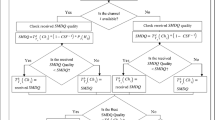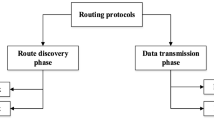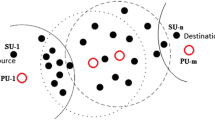Abstract
In recent times, Cognitive Radio Networks (CRNS) have been broadly investigated in light of the unceasingly growing demands of the Internet of Things (IoT) applications, paving the path to equipping IoT objects with Cognitive Radio (CR) technology. Thus, the implementation of these two technologies in unison has been attracting research interests. Today, CR technology is implemented in Ad-Hoc Networks (AHNs). This combination has several benefits, namely better coverage, lower costs, and simpler maintenance compared to infrastructure-based networks. Nonetheless, a limited number of researchers have lately paid attention to the area of Quality of Service (QoS) for being one of the key routing metrics adopted to define the optimal paths for the Cognitive Radio Ad Hoc Network (CRAHN). Accordingly, this work recommends the stability of a route in CRAHN and proposes Half -Duplex (HD) CRAHN routing protocol without Common Control Channel (CCC) using the control packets’ multicast transmission, referred to as Stability Based Multipath Downstream Quality Routing Protocol (SMDQRP). Interestingly, many CRN overheads have been reduced in the proposed routing protocol such as avoiding the overhead of transmitting the Route Request Packet (RRQP) over all channels and nodes. To be precise, we allow each node to transmit over all of its available channels instead of using all channels in the network. Further, every necessary calculation is made while the RRQP is being sent from the source to the destination not vice versa. Data transmission in HD mode with path recovery is used to test the proposed protocol, along with a compound accumulative routing metric named Stability Based Multipath Downstream Quality (SMDQ) to select the required QoS paths featured with the highest level of stability and maximal throughput. The path is recovered in data transmission by allowing the nodes in the path to use the already saved available channels between every two consecutive nodes in case of failure of any suggested channel. Moreover, a unique sensing technique based on energy level extracted from the received signals at a CR node along with waveform-based detection is factored in for their suitability to our proposed routing protocol as we aim to solve the problems in Multi-Cast-based Half Duplex Routing Protocol (MC-HDRP). The performance of the newly presented protocol is assessed and compared with the most relevant protocols called Probabilistic and Deterministic Path Selection (PDPS) and MC-HDRP by conducting several related simulation experiments and scenarios with the use of a special technologically advanced simulator based on Java language. Contrary to the MC-HDRP, the simulation’s results demonstrate an explicit significant improvement related to throughput, packet drop ratio, and the number of disconnected networks.




































Similar content being viewed by others
Data Availability
Data is available upon request from the corresponding author.
Code Availability
Custom code is available upon request from the corresponding author.
References
Khan, A. A., Rehmani, M. H., & Rachedi, A. (2017). Cognitive-radio-based internet of things: Applications, architectures, spectrum related functionalities, and future research directions. IEEE Wireless Communications, 24(3), 17–25.
Khan, A. A., Rehmani, M. H., & Rachedi, A. (2016). When cognitive radio meets the Internet of Things?. In 2016 International Wireless Communications and Mobile Computing Conference (IWCMC), IEEE, pp. 469–474.
Berlemann, L., & Mangold, S. (2009). Cognitive radio and dynamic spectrum access. John Wiley & Sons.
Saifan, R., Kamal, A. E., & Guan, Y. (2013). A cross-layer routing protocol (CLRP) for cognitive radio network. In 2013 IEEE Global Communications Conference (GLOBECOM), IEEE, pp. 896–901.
Darabkh, K. A., & Amro, O. M. (2020). New routing protocol for half-duplex cognitive radio Ad-Hoc networks over IoT environment. In 2020 IEEE International IOT, Electronics and Mechatronics Conference (IEMTRONICS), IEEE, pp. 1–5.
Cheng, W., Zhang, X., & Zhang, H. (2017). Pilot-based full-duplex spectrum-sensing and multichannel-MAC over non-time-slotted cognitive radio networks. In IEEE INFOCOM 2017-IEEE Conference on Computer Communications, IEEE, pp. 1–9.
Song, Z., Shen, B., Zhou, Z., & Kwak, K. S. (2009). Improved ant routing algorithm in cognitive radio networks. In 2009 9th International Symposium on Communications and Information Technology, IEEE, pp. 110–114.
AlQahtani, S., & Alotaibi, A. (2019). A route stability-based multipath QoS routing protocol in cognitive radio ad hoc networks. Wireless Networks, 25(5), 2931–2951.
Darabkh, K. A., Amro, O. M., Al-Zubi, R. T., & Salameh, H. B. (2021). Yet efficient routing protocols for half-and full-duplex cognitive radio Ad-Hoc Networks over IoT environment. Journal of Network and Computer Applications, 173, 102836.
Darabkh, K. A., Khazaleh, H. F., Al-Zubi, R. T., Alnabelsi, S. H., Salameh, H. B. An improved and stable routing algorithm for cognitive radio based iot networks. In Proceedings of the 9th international conference on internet of things: Systems, management and security (IOTSMS 2022), Milan, Italy. November, December 2022.
Saifan, R., Msaeed, A. M., & Darabkh, K. A. (2019). Probabilistic and deterministic path selection in cognitive radio network. IET Communications, 13(17), 2767–2777.
Aijaz, A., & Aghvami, A. H. (2015). Cognitive machine-to-machine communications for internet-of-things: A protocol stack perspective. IEEE Internet of Things Journal, 2(2), 103–112.
Darabkh, K. A., Zomot, J. N., & Al-qudah, Z. (2019). EDB-CHS-BOF: Energy and distance-based cluster head selection with balanced objective function protocol. IET Communications, 13(19), 3168–3180.
Darabkh, K. A., Wafa’a, K. K., & Ala’F, K. (2020). LiM-AHP-GCL: Life time maximizing based on analytical hierarchal process and genetic clustering protocol for the internet of things environment. Computer Networks, 176, 107257.
Kassab, W. A., & Darabkh, K. A. (2020). A–Z survey of internet of things: Architectures, protocols, applications, recent advances, future directions and recommendations. Journal of Network and Computer Applications, 163, 102663.
Jazebi, S. J., & Ghaffari, A. (2020). RISA: Routing scheme for internet of things using shuffled frog leaping optimization algorithm. Journal of Ambient Intelligence and Humanized Computing, 11(10), 4273–4283.
Mousavi, S. K., Ghaffari, A., Besharat, S., & Afshari, H. (2021). Improving the security of internet of things using cryptographic algorithms: A case of smart irrigation systems. Journal of Ambient Intelligence and Humanized Computing, 12(2), 2033–2051.
Seyfollahi, A., Moodi, M., & Ghaffari, A. (2022). MFO-RPL: A secure RPL-based routing protocol utilizing moth-flame optimizer for the IoT applications. Computer Standards & Interfaces, 82, 103622.
Seyfollahi, A., & Ghaffari, A. (2021). A review of intrusion detection systems in RPL routing protocol based on machine learning for internet of things applications. Wireless Communications and Mobile Computing. https://doi.org/10.1155/2021/8414503
Salameh, H. A. B., & El-Khatib, R. (2018). Spectrum-aware routing in full-duplex cognitive radio networks: An optimization framework. IEEE Systems Journal, 13(1), 183–191.
Darabkh, K. A., Amro, O. M., Al-Zubi, R. T., Salameh, H. B., & Saifan, R. (2020). Javasim-ibfd-crns: Novel java simulator for in-band full-duplex cognitive radio networks over internet of things environment. Journal of Network and Computer Applications, 172, 102833.
Almajali, S., Salameh, H. B., Ayyash, M., & Elgala, H. (2019). Extending NS3 to simulate cognitive radio wireless networks in a jammed environment. In 2019 Sixth International Conference on Software Defined Systems (SDS), IEEE, pp. 118–122.
Haider, Z., Hussain, R., Khan, I. L., Shakeel, A., Ijaz, B., & Malik, S. A. (2017). Evaluation of capabilities of open source cognitive radio network simulators. In 2017 13th International Wireless Communications and Mobile Computing Conference (IWCMC), IEEE, pp. 1814–1817.
Dong, Q., Chen, Y., Li, X., & Zeng, K. (2018). A Survey on Simulation Tools and Testbeds for Cognitive Radio Networks Study. arXiv preprint arXiv:1808.09858
Royer, E. M., & Perkins, C. E. (1999). Ad-hoc on-demand distance vector routing. In Proceedings of the 2nd IEEE Workshop on Mobile Computing Systems and Applications, Vol. 2, pp. 90–100.
Sefati, S., Abdi, M., & Ghaffari, A. (2021). Cluster-based data transmission scheme in wireless sensor networks using black hole and ant colony algorithms. International Journal of Communication Systems, 34(9), e4768.
Chowdhury, K. R., & Felice, M. D. (2009). Search: A routing protocol for mobile cognitive radio ad-hoc networks. Computer Communications, 32(18), 1983–1997.
Habak, K., Abdelatif, M., Hagrass, H., Rizc, K., & Youssef, M. (2013). A location-aided routing protocol for cognitive radio networks. In 2013 International Conference on Computing, Networking and Communications (ICNC), IEEE, pp. 729–733.
Jin, X., Zhang, R., Sun, J., & Zhang, Y. (2014). TIGHT: A geographic routing protocol for cognitive radio mobile ad hoc networks. IEEE Transactions on Wireless Communications, 13(8), 4670–4681.
Abbagnale, A., & Cuomo, F. (2010). Gymkhana: A connectivity-based routing scheme for cognitive radio ad hoc networks. In 2010 INFOCOM IEEE Conference on Computer Communications Workshops, IEEE, pp. 1–5.
Dutta, N., Sarma, H. K. D., & Srivastava, A. K. (2015). A multipath routing protocol for cognitive radio adhoc networks (CRAHNs). In 2015 International Conference on Advances in Computing, Communications and Informatics (ICACCI), IEEE, pp. 1960–1965.
Xin, C., Xie, B., & Shen, C. C. (2005). A novel layered graph model for topology formation and routing in dynamic spectrum access networks. In First IEEE International Symposium on New Frontiers in Dynamic Spectrum Access Networks, 2005. DySPAN 2005, IEEE, pp. 308–317.
Zhang, Y., Guan, J., Xu, C., & Zhang, H. (2012). The stable routing protocol for the cognitive network. In 2012 IEEE Globecom Workshops, IEEE, pp. 1090–1095.
Dong, C., Qu, Y., Dai, H., Guo, S., & Wu, Q. (2018). Multicast in multi-channel cognitive radio ad hoc networks: Challenges and research aspects. Computer Communications, 132, 10–16.
Ma, H., Zheng, L., & Ma, X. (2008). Spectrum aware routing for multi-hop cognitive radio networks with a single transceiver. In 2008 3rd International Conference on Cognitive Radio Oriented Wireless Networks and Communications (CrownCom 2008), IEEE, pp. 1–6.
Gottapu, S. K., Kapileswar, N., Santhi, P. V., & Chenchela, V. K. (2018). Maximizing cognitive radio networks throughput using limited historical behavior of primary users. IEEE Access, 6, 12252–12259.
Chaman, A., Wang, J., Sun, J., Hassanieh, H., & Roy Choudhury, R. (2018). Ghostbuster: Detecting the presence of hidden eavesdroppers. In Proceedings of the 24th Annual International Conference on Mobile Computing and Networking, pp. 337–351.
Avinash, N., & Tamilarasan, S. (2018). Performance analysis of different routing protocols in cognitive radio networks. Perspectives in Communication, Embedded-systems and Signal-processing-PiCES, 1(10), 164–168.
Acknowledgements
Not applicable.
Funding
This research received no external funding.
Author information
Authors and Affiliations
Contributions
KD and HK formulated the study idea, developed the protocol, and wrote the article draft. RA, SA, and HB edited the entire article.
Corresponding author
Ethics declarations
Conflict of interest
None declared.
Additional information
Publisher's Note
Springer Nature remains neutral with regard to jurisdictional claims in published maps and institutional affiliations.
Rights and permissions
Springer Nature or its licensor (e.g. a society or other partner) holds exclusive rights to this article under a publishing agreement with the author(s) or other rightsholder(s); author self-archiving of the accepted manuscript version of this article is solely governed by the terms of such publishing agreement and applicable law.
About this article
Cite this article
Darabkh, K.A., Al-Khazaleh, H.F., Al-Zubi, R.T. et al. Efficient Routing Protocol for Optimal Route Selection in Cognitive Radio Networks Over IoT Environment. Wireless Pers Commun 129, 209–253 (2023). https://doi.org/10.1007/s11277-022-10093-6
Accepted:
Published:
Issue Date:
DOI: https://doi.org/10.1007/s11277-022-10093-6




